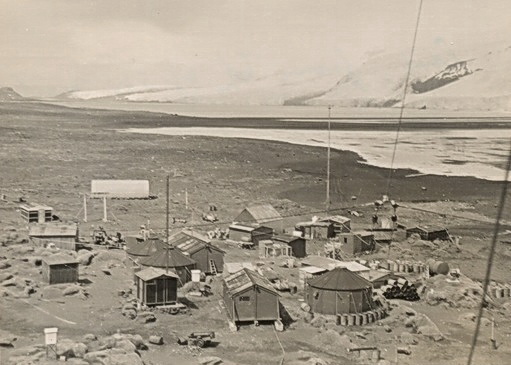
The Fourteen Men
who built and occupied the ANARE Station, Heard Island, 1947-48

|
[Left to right] A. R. "Doc" Gilchrist, Medical Officer [Source: Arthur Scholes, Fourteen Men, E. P. Dutton, 1952]
The party from the Australian National Antarctic Research Expedition (ANARE) arrived at Heard Island in December 1947. The 14 men spent 15 months at Atlas Cove, and constructed an entire small city, complete with a small power station, food store, mess, workshops, shower, toilet, electrical and plumbing stores, medical annex, biology lab, science lab, hen coop, dog run, and a large tractor. These men carried out meteorological, geophysical, upper atmosphere, and biological research, a program that continued for 7 years until the base was abandoned. Since 1969, ANARE has visited Heard Island every few years, mostly to check up on the ruins of the original encampment. The first amateur radio contact was made in 1947 by Arthur Campbell-Drury who signed VK3ACD/Heard. During the following 3 years, a total of only 36 contacts was made. The only American conact was with W6YC in San Francisco. The book Fourteen Men, written by Donald Scholes, provides a vivid description of the 1947 ANARE expedition, and the prospects for visitors to Heard Island: "As the ship approached the island, the bleak and dismal coastline became apparent. It accorded with my preconceived ideas land looked as though it would have knocked the heart out of any adventurer. "Dangerous reefs and treacherous shoals surrounded this island. Watchers who ventured on deck counted numerous glaciers through the breaks in the snow and mist. Some of the glaciers ran into the sea, forming fantastic shapes and patterns. There were tall pinnacles, like cathedral spires, and white grottoes, like pictures from a children's book of fairyland. The slopes above the glaciers ran for thousands of feet into the clouds. "Atlas Cove stretched out almost in a complete circle. The beach was stony and littered with hundreds of old dried bones, beaks, and animal skeletons. Here lay the bleached skeleton of a whale. Not a tree or shrub could be seen in the dismal landscape. Only the lower slopes and pressure ice ridges were visible through the hanging clouds and mist. "The elephant seals lay in heaps of four and five. They belched and threw up their heads when we approached. Opening wide their cavernous mouths, they made a disgusting noise, half-belch and half-growl, as if clearing their throats. 'Reeerrrrk, arrrrrrrrk.... arrrrk!' After this effort they relapsed into timeless slumber. "The petrels were revolting when they vomited, lightening their load to get airborne. Their companion birds pounced on these tasty morsels and wolfed them down. The island teemed with a grim prehistoric life, in which there was no room for the halt or maimed. "On the whole, the island was a depressing place. There was little beauty in the gaunt grey rocks, the barren flat and grim precipitous coastline. But despite that, there was something of almost indefinable loveliness about it. In the morning sunrise, the great mountain was a heap of sparking diamonds, reflecting flashing tints. When the sky behind the dome was the pale clear blue of the Antarctic, the mountain was awesome. When a full moon glinted round the ice slopes the dome shone like silver. At sunset, when the shadows flitted in long lines across the glaciers, the mountain top was a dome of gold." |
